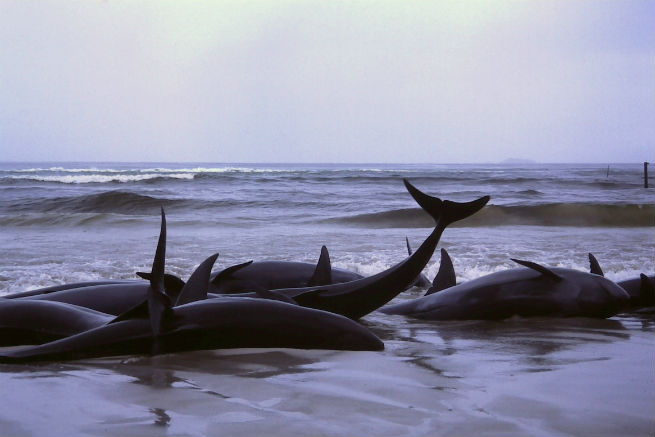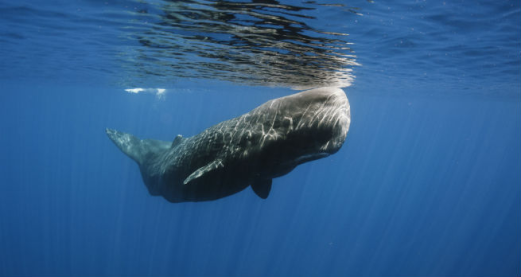Witnessing any dolphin or whale stranding live is a deeply moving experience; particularly when you end up accompanying an individual to the end of its life. My stomach still churns remembering the time that I encountered one in Scotland.
 Part of a pod of false killer whales that became stranded at Town Beach, Augusta, in Flinders Bay, Western Australia, at the end of July 1986
Part of a pod of false killer whales that became stranded at Town Beach, Augusta, in Flinders Bay, Western Australia, at the end of July 1986
But the reasons behind such events remain mysterious. Dolphins and whales can strand together – most recently, ten long-finned pilot whales became stranded on a beach near Calais, seven of which died – but we can’t pinpoint a single reason why this happens. Instead, many different factors appear to be involved.
Some mass strandings are easy to solve, because the individuals involved are similarly sick or injured. In these cases, they strand because they are pushed inshore by currents as they ail and die. Alternatively, they head for shore because they are simply too sick to swim.
Harmful algal blooms, for example, have been linked to mass strandings of whales as far back as the Miocene. Epizootics – disease events among an animal population – are also a common culprit. A morbillivirus (related to our measles virus) outbreak among dolphins in the North Atlantic caused several mass strandings along the US eastern seaboard in 1987 and 1988.
Even whales make mistakes
Accidents happen, too. Naval exercises, which may involve the use of high-powered sonar, have been linked to mass strandings as individuals become confused, or get injured or injure themselves trying to flee. Like human divers who surface too quickly, some even get the bends (decompression sickness).
There are also long-term trends, which are linked to tougher environmental conditions. Perhaps food stocks are low, temperatures are unusually high or low, or pollutants enter the water. Any of these factors could cause the mammals to behave differently.
Some studies also point to features on the coastline and at sea that might disorient whales and dolphins. Finally, even whales and dolphins make mistakes, as in the below video of a killer whale, filmed earlier this year.
It is also worth remembering that many of these species live in social groups. As in human communities, if an individual is affected by any of the factors above, then others travelling with it will also be exposed to the same problems.
An ocean mystery
But illness, injury and error aren’t always behind these events. Far more intriguing, it is not uncommon for some strandings to involve healthy animals, seemingly unaffected by any of these problems.
This is particularly true of pilot whale mass strandings, such as the recent Calais event. This has puzzled biologists for centuries: why would a healthy animal put itself in such danger if there is no reason to? Is it possible that they are deliberately harming themselves? Even attempting suicide?
Pilot whales live in matrilineal societies. They spend their lives in schools that are composed of extended families centred around the females – mothers and their daughters are the family focal points.
Based on this social structure, the common assumption has long been that healthy animals strand themselves as an altruistic gesture, that they do so to continue caring for distressed family members. Recent work, however, casts doubt on this analysis, with genetic tests showing that animals stranded close to each other during mass events may not be related after all. Perhaps this isn’t always a family tragedy.
So why strand?
The evolution of whales and dolphins is one of the best documented in the animal kingdom. These species evolved from land-based ancestors and share an ancestry with modern ungulates, think “cows-with-attitude”.
Their invasion of the sea was progressive, and therefore we are left to ponder whether in difficult times, individuals might still instinctively react as if land confers an element of safety.
Regardless of this, however, if injured or sick, these marine mammals will still be able to rest more easily if they can find a shallow area where they can stop moving. And that places them in hazardous situations.
While there are advantages to fleeing to or resting in shallow water, stranding is a messy business. It leads to further injuries, such as cuts and abrasions, as well as internal injuries caused by the unsupported weight of the body on internal organs – their bodies are designed to swim and float, not bear their mass on land. Often, it will lead to death.
Self-harm?
We simply don’t know why some apparently healthy whales and dolphins strand themselves. Which begs the question: are they doing it deliberately?
The social caring hypothesis still remains the favoured explanation at this stage: these individuals strand to stay in contact with their sick or injured companions, whether relatives or otherwise. What we don’t fully understand are the mechanisms behind this. These can range from simple ‘hardwired’ instincts to complex behaviours, which may allow them to reflect on the needs of other members of their group, even act altruistically. The truth probably lies somewhere in between.
How we can help
Thankfully, we have developed good techniques over the past 25 years to assess best strategies to save as many individuals as possible during a mass stranding. This involves a rapid triage process to know which individuals should be refloated first and the identification of the ‘problem’ individuals – those likely to be at the origin of the stranding.
The truth is that individuals will often re-strand and die hours or days after being refloated – doubtless because they were sick or injured in the first place – but some do get away.
We have learned a lot since Aristotle first wondered why these creatures strand together sometimes – and will never stop trying to help them. Establishing exactly why some of them do it, however, still eludes us.![]()
This article was originally published on The Conversation. Read the original article.


Rate and Review
Rate this article
Review this article
Log into OpenLearn to leave reviews and join in the conversation.
Article reviews